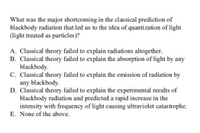Question

Transcribed Image Text:What was the major shortcoming in the classical prediction of
blackbody radiation that led us to the idca of quantization of light
(light treated as particles )?
A. Classical theory failed to explain radiations altogether.
B. Classical theory failed to explain the absorption of light by any
blackbody.
C. Classical theory failed to explain the emission of radiation by
any blackbody.
D. Classical theory failed to explain the experimental results of
blackbody radiation and predicted a rapid increase in the
intensity with frequency of light causing ultraviolet catastrophe.
E. None of the above.
Expert Solution
This question has been solved!
Explore an expertly crafted, step-by-step solution for a thorough understanding of key concepts.
This is a popular solution
Trending nowThis is a popular solution!
Step by stepSolved in 2 steps with 1 images

Knowledge Booster
Similar questions
- the n= tate. vels for Hydrogen. rbed photon? + tion from the thi 4. A light bulb used in a slide projector draws a current of 6 amperes when operating on 120 volts. a. What is the resistance of the light bulbs in ohms? b. What is the power consumed by the light bulb in watts? C. If two identical slide projectors are connected in parallel across the same 120 Volt source, what is the total current drawn from the source?arrow_forwardAccording to the theory of Photoelectric effect, the energy of a photon depends on its frequency. Which one will have highest energy of a photon? A. red light B. yellow light C. green light D. blue light E. all have the same energyarrow_forwardA photon of light has a frequency of 5.00 x 1014 Hz. If the frequency of the photon was doubled then which of these would happen to the energy of this photon? a. it would become one-fourth as much b. it would become half as much c. it would double d. it would quadruple e. it would triplearrow_forward
- 6. Given that the work function for a certain metal surface is 2.3 eV, find the stopping potential for photoelectrons ejected using incident light frequency of 7.0x1014 Hz. A. 0.9 volts B. 0.8 volts C. 0.3 volts D. 0.6 voltsarrow_forwardThe work function of cesium is 2.1 eV. ▾ Part A Determine the lowest frequency photon that can eject an electron from cesium. Express your answer with the appropriate units. Templates Symbols undo' rego Teset keyboard shortcuts Help Value Units Request Answer Part B Determine the maximum possible kinetic energy in electron volts of a photoelectron ejected from the metal that absorbs a 320-nm photon. Express your answer in electronvolts. Templates Symbols undo' redo Teset keyboard shortcuts Help Kmax= eV f= Submitarrow_forward
arrow_back_ios
arrow_forward_ios